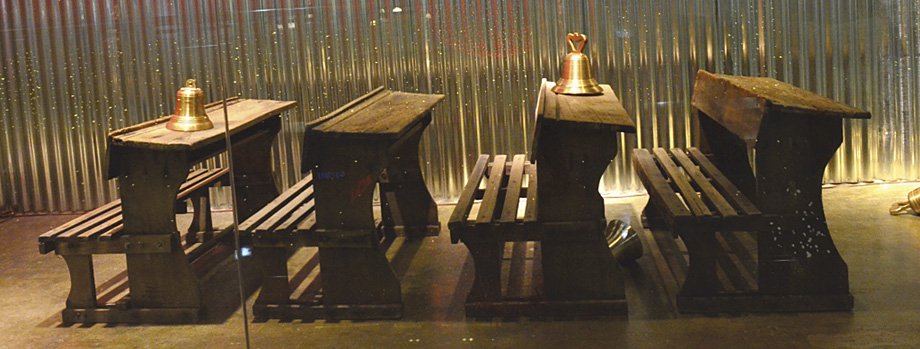Cultural Center of the Philippines
ENCYCLOPEDIA OF
PHILIPPINE ART
Day and Night
2011 / Installation / Artist: Roberto Chabet / Paseo Gallery and Cultural Center of the Philippines
Installed first at Paseo Gallery in one of the largest malls in Metro Manila, and then again as part of a larger retrospective at the site of Roberto Chabet’s first state posting as museum director of the CCP, the room-size installation Day and Night may be understood in reference to both physical and social contexts. Those reared and schooled in the Philippines would know that the classroom is not merely a place for knowledge generation but a circulator of “politicized” memories (Olazo 2011). Through the installation, Philippine public classrooms may be construed not merely as learning sites but as halfway places for the evicted and displaced, as well as possibly nesting places for the aberrant. These spaces additionally double up as ceremonial sites for the practice of civil agency and the imposition of moneyed and militarized power, poignantly represented by images of public school teachers drafted for election duties.
The work demonstrates Chabet’s agile mining of both the formal and meaning-making capacities of everyday objects played off against each other. His use of ubiquitous GI sheets, other discards, and found objects like a bell from an old boat, wooden school desks, and neon text encased within the narrow space of a mall-based gallery, calls up dual performances of voyeurism and surveillance in a controlled space of commerce and mass socialization such as a mall. Not a few have faulted Chabet’s work for being too opaque. In response, protégé artist Jonathan Olazo’s exhibition text expressly points out Chabet’s use of objects, such as a Jose Rizal magic slate where written codes are easily effaced, is semiotically charged. Further reading could also suggest that school bells may be taken both as harbingers of warning and as instruments for getting things and people to conform to a prescribed order.
Day and Night was last installed a year before the artist’s passing as both the Philippine and Asian art worlds were reconsidering how Chabet might figure in the art histories of the region. Through it and other works reinstalled for the yearlong tribute to the artist-teacher-curator organized by his students and peers in 2011-12, Olazo and his colleagues asserted their mentor’s place within a “developing avant-garde.”
Written by Maria Eileen Legaspi-Ramirez
Source
Olazo, Jonathan. 2011. “Notes about the Exhibition, Paseo Gallery.” (Also reproduced for Roberto Chabet: Fifty Years, King Kong Art Projects Unlimited, 2012.)
